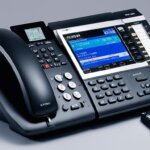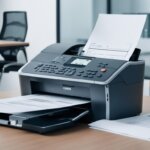Table of Contents
Fax technology has been around for decades and has played a significant role in communication. Despite the emergence of modern communication strategies, faxing remains relevant in the digital age. In this comprehensive guide, we will explore the fundamentals of fax technology, its role in communication, and how it has adapted to keep up with the ever-changing technological landscape.
So, what is a fax? In simple terms, a fax is a method of sending and receiving documents over a telephone line. It uses analog or digital technology to scan a paper document and then converts it into a digital format that can be transmitted over a phone line to a recipient’s fax machine. This process enables documents to be sent securely and quickly, making it a popular option for businesses and individuals alike.
Key Takeaways
- Fax technology has been around for decades and remains relevant in the digital age.
- A fax is a method of sending and receiving documents over a telephone line.
- Faxing enables documents to be sent securely and quickly, making it a popular option for businesses and individuals.
- Fax technology has evolved to keep up with the ever-changing technological landscape.
- Understanding the fundamentals of fax technology is essential in comprehending its significance in modern communication systems.
The History and Evolution of Fax Technology
Fax technology has come a long way since its inception in the mid-19th century. Early telegraphs used a scanning system that marked incoming messages onto a roll of paper, which was then transmitted and printed out at the receiving end. Later advances in technology allowed for faster and more precise transmission, and in 1964, the Xerox Corporation released the first commercial fax machine – the Long Distance Xerography (LDX) machine.
Over the following decades, fax technology continued to improve, with the introduction of thermal paper and the integration of fax machines with computers. In the 1990s, the internet age brought about a rapid shift towards digital faxing, where documents could be sent and received using email and online faxing services. Today, we have advanced digital faxing methods that make it possible to scan, store, and send documents from anywhere in the world, at any time.
The development of fax technology has been driven by the need for faster, more reliable communication methods. By understanding the history and evolution of fax, we can appreciate how far we have come in terms of document transmission and the significant role fax technology has played in shaping modern communication.
How Fax Works and Its Role in Communication
While some may consider fax an outdated form of communication, the truth is, it still has an important role to play in many industries today. In this section, we will explore how fax works and why it is still a reliable and secure method of communication.
How Fax Works
The basic principle of faxing is relatively simple. A fax machine scans a paper document and converts the information into a digital signal. The signal is then transmitted over a telephone line to a receiving fax machine, which decodes the signal and prints a copy of the original document.
One key advantage of faxing is its ability to transmit hard-copy documents quickly and securely. Unlike email, which can be vulnerable to hacking and security breaches, faxes are transmitted over dedicated phone lines, making them much less susceptible to interception.
However, traditional faxing does have some limitations. For example, it can be slow and unreliable over long distances or if the phone lines are busy. That’s where digital faxing comes in.
The Role of Fax in Communication
Despite the increasing use of digital communication methods, there are still many situations where faxing remains the preferred option. In some industries, such as healthcare and legal, faxed documents are considered legal records, and there are strict regulations in place for how they should be handled.
The financial industry also relies heavily on faxing, particularly for transmitting sensitive personal and financial information. In fact, many financial institutions require clients to fax documents such as loan applications or wire transfer requests.
Finally, many businesses still use faxing as a secure and reliable method of communication with their clients and customers, particularly for sending signed contracts or other legal documents.
“Faxing is still a reliable and secure method of transmitting hard-copy documents, and it plays an important role in many industries today.”
The Digital Age: Fax in the Modern World
With the rise of digital technology, faxing has also undergone a significant transformation. Gone are the days of bulky fax machines and inconvenient transmissions. Today, digital faxing offers a multitude of benefits and challenges in modern communication systems.
Benefits of Digital Faxing
- Accessibility: With digital faxing, users can send and receive documents from any device with internet access, making it a convenient and flexible option.
- Cost-Effective: Digital faxing eliminates the need for expensive hardware and phone lines, reducing the cost of fax transmissions.
- Eco-Friendly: By eliminating the need for paper, ink, and toner, digital faxing is a more sustainable option, helping to reduce waste and conserve resources.
Challenges of Digital Faxing
- Security Risks: As with any digital technology, digital faxing is vulnerable to security threats like hacking and data breaches.
- Reliance on Internet Connectivity: Without a stable internet connection, digital faxing may not be a reliable mode of communication.
- Compatibility Issues: Not all digital faxing services are compatible with all file types, leading to potential formatting or file transfer issues.
The Role of Online Fax Services
Online fax services have revolutionised the way digital faxing is done today. By offering cloud-based storage and real-time notifications, users can access their faxes from anywhere, at any time.
It’s estimated that by 2025, the global market size for digital faxing is expected to reach $2.4 billion.
In conclusion, digital faxing has transformed the way we communicate, offering accessibility, cost-effectiveness, and eco-friendliness along with new challenges such as security risks and compatibility issues. Online fax services have made it easier than ever to access and send faxes, making digital faxing an essential tool in the modern world.
Conclusion
Having explored the fundamentals of fax technology and its impact on communication, we can appreciate its significance in modern communication systems. While email and other digital methods have gained popularity, fax remains a reliable and secure method of transmitting documents.
In conclusion, understanding what a fax is goes beyond its definition as a document transmission method. Fax technology has a rich history, and it has played a crucial role in communication for decades. As we continue to embrace the digital age, faxing has adapted to meet the changing times, proving its relevance and importance in modern communication systems.
FAQ
What is a fax?
A fax, short for facsimile, is a method of transmitting documents over telephone lines. It allows users to send printed or handwritten materials to a recipient, who can receive and print the documents on their end.
How does fax technology work?
Fax machines or online fax services convert documents into electronic signals, which are then transmitted over telephone lines to the recipient’s fax machine or inbox. The signals are then converted back into images or text, allowing the recipient to view and print the documents.
What is the role of fax in communication?
Fax has traditionally been used as a reliable and secure method of transmitting important documents, such as contracts, legal papers, and medical records. It plays a crucial role in industries where physical documents are still required for legal or record-keeping purposes.
How has fax technology evolved over time?
Fax technology has come a long way since its inception. From early telegraph-based systems to the modern digital faxing methods, advancements in technology have made faxing faster, more efficient, and convenient. Today, many businesses and individuals rely on online fax services for their faxing needs.
What are the benefits of digital faxing in the modern world?
Digital faxing offers several advantages over traditional fax machines. It eliminates the need for dedicated fax lines, reduces paper waste, and allows users to send and receive faxes directly from their computers, smartphones, or tablets. Online fax services also offer features like document storage, integration with email systems, and enhanced security measures.
Are online fax services secure?
Yes, reputable online fax services employ encryption and other security measures to ensure the confidentiality and integrity of transmitted documents. They also comply with industry standards for data protection and privacy. However, it is advisable to choose a trusted provider and follow recommended security practices when using online fax services.







